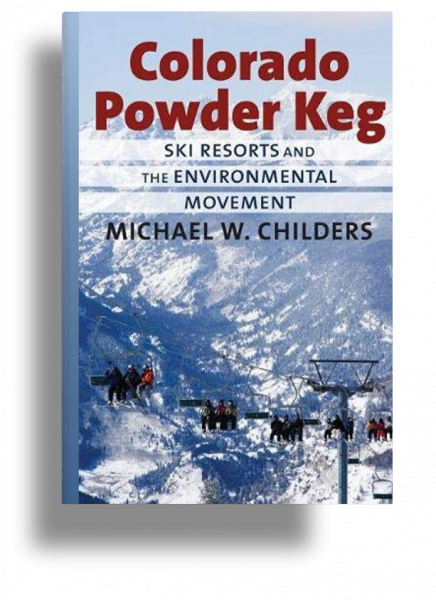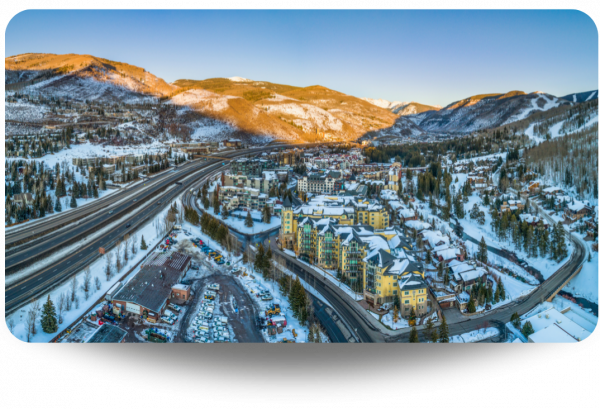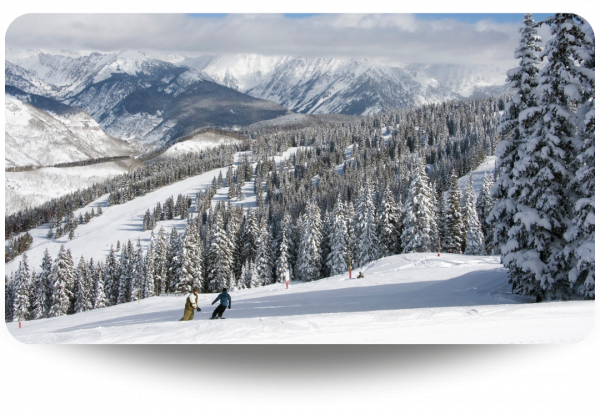A Brief History of Colorado’s Ski Expansion with Colorado Tourism and Ski Historian Michael Childers
Listen to Ski Historian Michael Childers on the Audit below:
The route along Interstate 70 (I-70) from Denver to Vail Ski Resort stretches a little more than 100 miles. Along that route, you’ll pass under the Eisenhower Tunnel, through Copper Mountain, and go past exit ramps to ski towns like Breckenridge or Winter Park.
As you roll through the mountains sitting alongside I-70, you won’t be alone—you’ll be accompanied by a fraction of the more than 13 million ski-season travelers, carving through the interstate who also decided to head to the mountains this weekend.
“There’s an increased use and a larger recreational footprint in our national forest and national parks within Colorado, where you really can’t escape people at all anymore,” Associate Professor of History Mike Childers says. “People are going further and further to not only ski, but backcountry ski, snowmobile, hike, mountain bike, or dirt bike.”
Last year, with its corporate arm stretched across Colorado, resorts like Vail Ski Resort attracted 14 million skiers . As snowfall continues to drop to record lows in Europe, congestion along I-70 shows no sign of slowing down for future ski seasons.
“The ski industry is reflective of a much larger growing popularity of outdoor recreation that has really consumed most of the state and has environmental implications on those regions,” Childers says.

As Colorado’s go-to ski historian, in large part due to his award-winning work in his book Colorado Powder Keg, Childers (an avid skier himself) often finds himself opposite interviewers seeking to better understand one of Colorado’s most profitable industries. Recently featured on SOURCE’s The Audit Podcast, Childers sat down with the Department of History to discuss Colorado’s ski expansion and the impact of growing tourism.
You connect the density in and around Colorado ski areas to urban sprawl—what is sprawl when it comes to the route along I-70?
Sprawl is a term largely thought about in urban growth where you have suburban housing that sprawls across the landscape. Sprawl, particularly if you look at the I-70 corridor, occurred when you have the core economic activity—the ski area—attracting people who want to live in these beautiful places, and people who want to work in these places. They [real estate developers and homeowners] then started building further and further away from the ski area and largely up and down the I-70 corridor. If you think about I-70, it’s just an extension of the front range in the Denver metro area into the mountains.
So expansion of I-70 is not directly related to sprawl, but to tourism?
The thing that’s fascinating about tourism, whether it’s a ski area, national park, or a lake, is that those service kind of industries have become the driving

economic forces for a lot of the rural parts in the American West.
Rural areas have largely made a shift from ranching, mining, and timber-based economies into tourism-based economies, which has driven a lot of the sort of growth that we’ve experienced over the last half century or more.
I-70 was purposely built for the tourism industry in Colorado, specifically the ski industry. When they [Congress] passed the Interstate Highway Act in 1956, I-70 was supposed to end in Denver because building a highway or an interstate through the mountains is hard and expensive.
What has made the traffic so congested with no alternate routes?
There is a geographic problem of living in the mountains—they’re hard to get through, especially the high Colorado Rockies. You only have one route through them right now of any sort of size, and as the industry in the Western Slope has developed (particularly on Saturday mornings and Sunday nights), it’s the only way to and from a lot of these large ski resorts that are attracting the millions of skiers every year.
 That has continued to compound these sorts of problems of the gridlock back and forth into the mountains. More and more skiers keep going to these areas, largely because these are the only places with heavy snow.
That has continued to compound these sorts of problems of the gridlock back and forth into the mountains. More and more skiers keep going to these areas, largely because these are the only places with heavy snow.
Interestingly, though, ski traffic gets all the attention. Summer traffic is worse because it’s easier to drive during the summer and people don’t like the cold, but they love the beauty of the mountains in July.
What is the role of the Forest Service when it comes to this expansion of ski resorts’ land usage?
Most ski resorts are built on national forests. That means the Forest Service is the one who’s permitting them and managing those permits. Ski resorts have to have a 30-year permit and within a certain boundary, like within a national forest, that they’re allowed to develop trails, build infrastructure and then make money—all of which is in conjunction with the Forest Service.
All this is largely built upon older ideas of permit systems for grazing and timber and mining. But ski resorts have become almost semi-permanent fixtures on national forest lands. Interestingly, though, it’s important to think about that of all the national forests, ski resorts have played a disproportionately large role in their management but make up less than one-tenth of 1 percent of all national forests in the country.
How did ticketing and passes become managed by ski resorts instead of the Forest Service?
Skiing on Forest Service land of this scale really emerged in the 1920s and 1930s. It’s really when you see a lot of this [expansion], and the Forest Service is actively participating in developing ski hills. After World War II, skiing exploded in popularity and the Forest Service realized that they could not manage ski resorts when they were under a federal agency.
It’s not within their mandate, so they turned to private enterprises to run these hills, and that’s when hills really went from hills to ski areas to ski resorts and began growing.

Breckenridge is a perfect example of this. It grows in the 1960s and it grows to a larger scale because it’s run by a corporation. The Forest Service had various different ways in which they controlled lift ticket prices because there was a true belief that these are public lands that should be accessible to the public for their use and enjoyment.
By the 1970s, you start to see a shift in thinking about how the federal government should work and therefore how federal lands work. There was a push to deregulate the ski industry lift ticket prices under the Carter administration, and it removed the cap and any regulatory ability the Forest Service had over one-day lift ticket prices, so then the prices shot up.
I think the first year they [ticket prices] shot up several hundred percent and that is when, to a certain point within the mid-1980s, where you started to see ski areas consolidate under different ownerships under Vail Resorts. In consolidating, they realized that they could package lift passes—meaning that you could buy a single pass that would give you access to all your resorts under the control of different corporate entities.
What has been the impact of corporate entities now controlling the ticketing and pass systems?
This has merged into what we have today with Ikon and Epic passes. These are two large, one corporate and one private fund investment firm packaging, where you buy a single pass that gives you access to all the different ski resorts under their ownership. This made skiing a lot more accessible to a lot of people. Early on, these passes cost about $200 per season, so people were buying them like Big Macs, and then they became progressively more and more expensive.
They are affordable enough that they sell them widely across not just Colorado and the West, but in the whole country and the world. They make a lot of money quickly and do not ever really have to provide access. Most skiers ski 5 to 10 days a year if they’re very active; it’s very few people who go 100-plus days a year.
So economically, they’re a good deal for the ski industry and an increasingly good deal for skiers, except for the fact that you’re seeing more and more people on the mountain. It’s leading to

overcrowding in places like Utah, Colorado, and California, where everyone who has an Ikon pass shows up on the same day at the same time.
What historical events best emphasize the divide between the economics of the ski industry and the environmentally concerned people of Colorado?
The first one was the fight in the early 1970s, for the Olympic Games in Colorado. Colorado was awarded the Games largely based on the idea that it was going to attract ski tourists to the state. At that moment, the ski industry was really growing.
This is happening while there’s a growing awareness and concern over Colorado’s rapid growth and its impact on its environment, its tax base, and its quality of life. Those three things led to a multiyear kind of fight that ended with the voters rejecting hosting the Games, which is the first and only time in Olympic history that a host city was awarded the Games and then rejected them.
But, probably the most notorious environmental story was in 1998. Members of the Earth Liberation Front, or the E.L.F., burned down a massive ski lodge and a couple of other buildings on Vail Ski Resort. They did this to protest and draw attention to Vail Resorts as it was going to expand on the backside of [Battle Mountain], which was the known habitat for the rare, endangered Canada Lynx—which had been listed as a threatened species by the federal government some time before, and really had been pushed out of the area by Vail Resorts and by the growth upon it.
This group of radical environmentalists saw this threat as a way to protest this kind of capitalism and its impact on the environment and made Vail’s expansion kind of front-page news across the country at that time and drew attention to skiing’s real environmental impacts, particularly on wildlife and on public lands. It was an absolute failure in terms of stopping the resort.
It turned the resort from being the bad guy, into being the victim.

Vail Resort would go on to expand its ski site into Battle Mountain, which ultimately opened to be what is now known as Blue Sky Basin in January 2000 and quickly became one of Vail’s most popular ski sites.
To learn more about the escalation and expansion of the ski and tourism industry, purchase Colorado Powder Keg online or access it at CSU’s Morgan Library. Contact Ski Historian Michael Childers for media inquiries here.